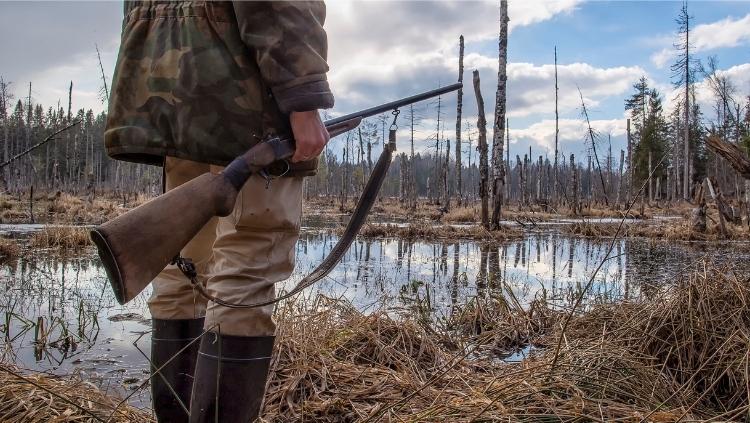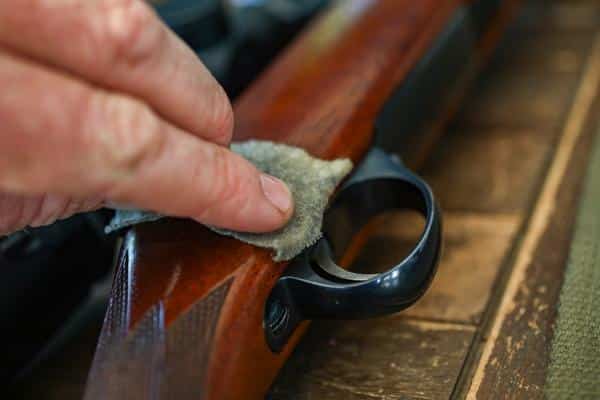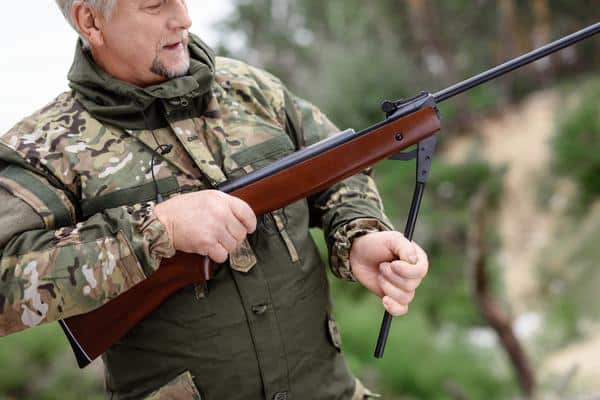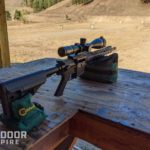Hunting can involve carrying and using many tools.
Boots, backpacks, and radios can all be important to the success of your hunting trip. But the essential tool for most hunters is their trusty rifle.
All rifles are made of metal. Inclement weather can cause your rifle to corrode, rusting inside the bore or bolt, and ruining the firearm.
This is a slow enough process for most people not to realize it’s happening until it’s too late.
Generally, all you need to do to protect your rifle from the weather is to clean and oil it after every hunting or shooting trip. If you’ll be in the field for several days, however, you’ll want to use grease or wax for additional protection and consider bringing along a silicone-treated gun sock.
Continue reading to learn how to best protect your hunting gun for when the weather turns bad.
Why is My Gun Rusting?
Most firearm components are made of steel. Steel is mostly iron, which makes guns susceptible to rust.
Rust is a type of corrosion that happens when iron is exposed to oxygen and water for a while. The iron in the steel turns into iron oxide and iron oxide-hydroxide.
Salt makes the process speed up because of chloride ions in the salt. This type of rust expands and spreads, damaging the gun.
Surface rust isn’t really a problem. It’s just ugly. But rust left unchecked can form pits and cause parts to seize together. Stop it before it starts!
Will Rain Hurt My Rifle?
Rain, by itself, does not hurt guns.
That water has to penetrate the steel, where it contributes to the chemical reactions that lead to rust.
So, a little water on your gun won’t cause any problems unless it has a terrible finish or was left as raw, unfinished steel.
Fortunately, oil displaces water, so a well-oiled gun protects against rain. But expose the rifle to water long enough and water will get past the oil and you’ll find your gun rusting!
Let’s protect your precious firearm.
The Best Hunting Rifle Protection Methods
When it comes to protecting your gun, there are two basic methods you can use to keep it safe:
- Treating your gun to resist the elements
- Encasing it in an object that provides physical protection
These sound fancy but I bet you already use both techniques.
Treating your gun is as simple as keeping it oiled and this is sufficient for a gun that travels from the safe to the shooting range and back. I’ll cover why this is not enough for those serious hunting trips later.
The other technique uses something like a gun case or gun sock. These add layers of padding and soft or hard physical protection.
But you shouldn’t keep your rifle in that gun sock while you’re hunting (or even in storage at home!)
Keep Your Rifle Safe with Gun Bags and Cases
Hard-sided gun cases can protect your rifle from being smashed. Soft-sided cases are lighter, fit in your truck better, and offer plenty of protection. Gun socks fit your rifle’s form and offer adequate protection against scratches.
So why don’t you want to carry your gun in one of these while actively hunting?
Several reasons, actually. But the biggest problem is moisture.
A scratch may interrupt your gun’s aesthetics and a nasty bump may knock your rifle’s sights out of alignment. But these are minor problems.
Moisture being held against your gun contributes to that enemy of gun owners everywhere: rust.
And any sort of soft lining inside a gun case is capable of holding moisture against your rifle. Especially if you’re outside and that soft case gets wet, whether from rain or humidity.
And if you leave your gun in that case long-term, you may open it up next season to find mildew covering everything!
This is why you shouldn’t store your guns long-term in a case. These objects protect against damage during transportation, not for permanent or field use.
Gun socks are a different story.
Do Gun Socks Prevent Rust?
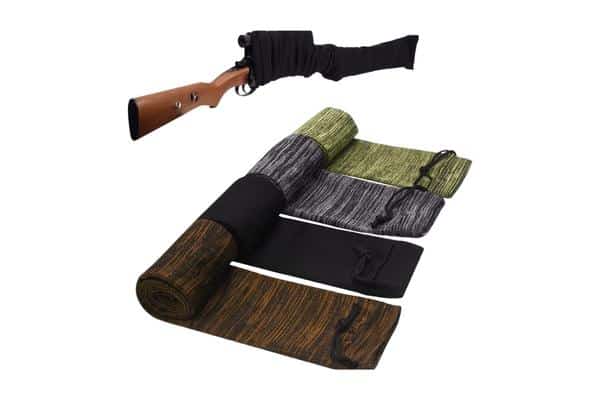
Silicone-treated gun socks are much better than traditional gun socks or gun cases. In fact, they are great at keeping moisture away!
However, I do not keep my hunting guns in a gun sock in the field.
Even if the silicone helps prevent corrosion, you’re still slowing down how quickly you can get to your gun.
Sometimes you have just a few seconds to shoulder your rifle, bring the sights onto that deer, and pull the trigger.
Do you want to risk your shot at that monster buck because of a gun sock?
That said, they can still be an excellent choice for protecting your rifle or shotgun from morning dew as you walk to your hunting spot. Or you can toss one on to minimize exposure when it starts to rain.
If you have room in your hunting backpack, it may be a good idea to keep a silicone-treated gun sock with you.
Treat Your Rifle Right to Prevent Rust & Damage
90% of keeping your rifle protected from harsh weather is to keep it treated with the right chemicals.
Whether you’re hunting in the driest desert or the wettest rainforest, the right amount of the right oil, grease, or wax in the right place is all you need to keep your gun operating smoothly without corroding.
But not all gun treatments are equal.
Keep Your Rifle Clean and Oiled
The first step is to ensure your gun is clean before entering the field.
Contaminants can attract and hold onto moisture, especially in the vulnerable insides of your gun where you may not see rust forming until it’s started to pit the steel.
Generally, you only need to give your gun a basic clean after shooting it.
After heavy use or anytime it’s exposed to dust, sand, or rain, you’ll want to give your gun a deep clean.
Make sure it’s well cleaned and lubricated inside.
My two favorite gun oils are Slip 2000 Extreme Weapons Lubricant and FrogLube, depending on whether I’m using the firearm in a cold or warm environment.
I use Slip 2000 EWL in Alaska and FrogLube in the lower 48. Both are capable Clean Lube Protect (CLP) products, though proper application differs between the two.
How Often Should I Oil My Gun?
You should oil your guns every time you clean them. Solvents and cleaning rags can strip away oils, which you need to reapply.
Also, oil can dissipate over time. The standard advice is to oil guns in your safe at least once every six months. More humid environments require you to oil your guns more frequently than this, though.
Also, it’s a good idea to ensure your gun is properly oiled before you rely on it.
So, I oil my guns before every hunting trip.
And my carry guns are oiled once a month, even if I don’t shoot them.
The Problem with Using Oil to Protect Your Gun from the Weather
But oil has a weakness when it comes to protection against the elements: It’s relatively easy to remove from the metal.
A heavy enough rain can wash away light coatings of oil. Since you shouldn’t heavily-oil your gun, this is a problem!
And some oils can attract dust, dirt, and grime, which can gum up your gun, even discounting the corrosion aspect.
Plus, your clothes and even skin can wipe away oil, leaving the gun unprotected. High-quality oils mitigate these problems but don’t entirely prevent them.
This is why I recommend using something stronger outside your gun to prevent water ingress.
Step Up Your Game with Grease
Grease is similar to oil but it’s thicker and sticks to metal better.
This makes gun grease a superior product for the outside of your guns. It’s less likely to get wiped off by accident, so it’ll protect your gun from rainstorms for longer than light oil will.
Now, grease’s thickness means you may not be able to treat your entire firearm with it. It can be too thick for tightly-fitted parts.
I have had success using white lithium grease on over/under shotgun pivots and Glock rails but I wouldn’t use it inside my AR’s bolt carrier group.
Grease is great for high-wear areas and the outside of your rifle, though.
Use Microcrystalline Wax for the Ultimate Weather Protection
Microcrystalline wax is my favorite chemical for keeping the outside of my firearms safe from rain, sweat, and more.
This type of wax, not to be confused with car wax, forms a hard finish that stays on better than grease and offers superior physical protection.
I used to have problems with my finger oils, causing rusty fingerprints to form on the outside of my guns.
I’d have to wipe down my firearms after every time I touched metal, whether hunting, target shooting, or even showing them off to my friends at home.
Since I’ve started waxing my guns, this problem has been solved!
Now, wax does have a downside when compared with oil and grease: It’s not a lubricant. At least not enough of a lubricant for most firearms.
This means you’ll want to apply wax to only the outside portions of your gun, not including parts like bolts open to the outside when using the gun.
If this is a new concept to you, then go ahead and pick up a canister of Renaissance Wax and check out my instructions on how to properly wax your firearms.
Renaissance Wax is designed to preserve museum artifacts, so it’s good enough to waterproof your guns. Even against a thunderstorm.
Don’t Forget Your Rifle’s Stock
The metal components of your hunting rifle are not the only parts susceptible to damage from the elements.
Wood stocks can also be susceptible to damage from moisture, though not because of corrosion.
Instead, water can work its way inside the wooden fibers, filling them up and causing the stock to swell and crack.
How you’ll want to keep your stock safe depends on how it was initially finished.
Some wood finishes are waterproof for long periods. Others, such as oils, produce wonderfully looking and feeling stocks but require upkeep.
Varnishes can last for a decade or longer and so require minimal upkeep.
Both shellac and a glossy polyurethane finish are long-lasting, durable treatments requiring little upkeep.
Generally, you’ll want to maximize your stock’s protection by giving it an additional dose of the same type of finish originally applied.
If you’re unsure how your gun stock was first treated, microcrystalline wax is a great choice for additional protection.
What About Your Rifle’s Finish?
How your rifle was finished greatly affects how much attention you need to pay when protecting the gun.
A nice, deep-blued finish looks gorgeous. However, bluing is thin and easily scratched. You’ll want to keep it well protected.
Parkerization is tougher and can survive the elements better but still needs to be oiled.
Chroming guns were an early attempt at making rifles basically waterproof and needs little care. But it’s not rustproof so you’ll still need to protect it.
Same with stainless steel. It’s stainless steel, not stainproof steel, so it needs some protection. But it’s a great choice for rifles that will see wet weather.
The recent wonder finishes such as diamond-like carbon (DLC) and nitride finishes need even less attention paid to them. If I can choose, I buy and build my hunting and carry guns with these finishes, even if they’re more expensive.
The extra peace of mind in the field is worth that expense. I have had no corrosion troubles hunting in the Tongass National Forest, a temperate rainforest, with my AR-15s made from anodized aluminum and nitrided steel.
Aluminum is practically corrosion-proof. It won’t rust, though it can still corrode under the right circumstances.
However, aluminum produces a protective layer of aluminum oxide when exposed to the air. So, for most hunters, you can consider aluminum to be element-proof.
Taking a rifle with the right finish out into the field can vastly increase your confidence that you won’t return home with a pile of rust. But every gun has vulnerable interior parts so not even the best finish will excuse you from caring for your rifle.
Field Gun Protection Tips & Tricks
In addition to properly treating your rifle, here’s some information to keep in mind as you travel through the wilderness in pursuit of game.
Be Mindful of Your Gun
It’s easy to carelessly handle your rifle when you’re traversing through a forest or across a field.
However, many threats to your gun can be avoided by always keeping your gun, especially its muzzle position, in your mind.
Never let the rifle’s crown touch anything while you’re outdoors. Keep it up and out of sand and mud, be careful when setting it down so it doesn’t fall over, carry it high when wading through streams, and angle the bore downward when rain strikes.
Basically, you want to minimize the amount of water entering your barrel.
Protect Your Scope
Any good rifle scope will be waterproof so you don’t have to worry about using it in the rain. However, your rifle’s optics are vulnerable to damage from physical trauma.
I like to use Butler Creek flip-up scope caps on my hunting rifles. Scope covers are also a good idea. Many scopes come with caps, a cover, or both.
If a storm is approaching, you can tie a plastic bag around your scope to keep it dry in the rain.
Keep the Action Closed
When you’re traveling, always keep your rifle’s bolt closed. This will minimize the amount of water that can get into the rifle’s action.
Many semi-automatic rifles have a dust cover. Keep it closed.
For example, when hunting with an AR-15, get into the habit of closing the dust cover every time you charge the rifle. It’ll open automatically when you fire.
Kalashnikov rifles have their dust cover built into the safety selector lever. For those, keep the gun on safe until you need to shoot.
Avoid Corrosive Ammo
Corrosive ammunition is not as big of a problem as it used to be since most corrosive ammo on the market has been shot by now.
However, it’s still a good idea to pay attention to your ammo’s country of manufacture and to select the cleanest-burning powder you can find.
Avoid Saltwater (and Sweat!)
Saltwater can kill guns in a surprisingly short time, so you want to be extra cautious when hunting around the ocean.
All that salt in the water can kickstart the rusting process.
If you can’t avoid getting your rifle wet with ocean spray when traveling to that perfect hunting spot, then rinse your gun with fresh water at the earliest opportunity.
At the very least, wipe away any wet spots to keep the gun dry until you can wash off the salt.
And sweat is saltwater produced by your body.
Concealed carry pistols are especially at risk of rusting from sweat. I’ve worked up quite the sweat when hiking to a hunting location before, which can get on the gun.
Get that sweat off as quickly as possible.
Grease and wax are good at minimizing the dangers of sweat and saltwater exposure.
Use a Muzzle Cap
Muzzle caps are sometimes called barrel condoms. Most of the ones you can buy do look like miniature condoms.
If you’re in a particularly wet area, then fit one of these over the muzzle end of your gun before it gets exposed to water. This keeps the bore nice and dry.
Plus, if you need to take a quick shot, you can shoot through this thin material without issue.
You can also find plastic muzzle caps or make your own out of wood or leather, but don’t shoot through those!
Note that you shouldn’t use a muzzle cap if your bore has gotten wet because it’ll prevent the bore from drying out.
Open the Action to Remove Water
If your bore gets filled with water, whether from rain or an accidental drop into the water, surface tension and a vacuum effect can prevent the water from flowing back out.
The effect is similar to when you stick a straw into your drink, cover the top with your finger, then pull out the straw. The liquid will stay in the straw until you release your finger.
If water is stuck in your bore, point the muzzle down and pull back the bolt slightly. This will break the vacuum seal and release the water.
Dry the Rifle as Soon as Possible
If your gun has been exposed to large amounts of rain, you need to get that water away from your gun as soon as you’re able.
Water can only cause corrosion while it’s physically touching the metal.
After a heavy deluge or dip in the water, if you’re back at base camp, you’ll want to strip your rifle so all wet parts are open to airflow. This will allow the gun to dry as quickly as possible.
If you can, use a fan to blow air over your gun to speed up the drying process.
Heat can also help, but don’t put the gun too close to a fire. Too much heat can warp wood and polymer components, ruining your hunting trip.
And whatever you do, do not put a wet gun into a gun case!
The rifle won’t dry out in a case so you’ll just be keeping it exposed to water for longer, contributing to harmful corrosion.
Just Use Ballistol Everywhere
Some people also swear by Ballistol.
Ballistol is non-toxic and a fine lubricant with a long history of use by hunters and soldiers.
It’s also one of the few gun oils that doesn’t cause wood to swell, making it a good choice as an all-in-one protective product for your entire rifle.
However, you’ll want to apply Ballistol more frequently than other oils, greases, or waxes.
But it’s great if you want to carry just one bottle with you so I recommend it to people who want to travel lightly or who don’t want to use multiple products on their guns.
Other than having to reapply Ballistol more than other choices, it has an extra downside for some people: Ballistol has a strong scent.
I like how Ballistol smells, but some people cannot stand it. But a slightly smelly gun is better than a rusty gun!
What About When the Rifle is in Storage?
Rifles, pistols, and shotguns in storage do not need much care.
Put them away clean, check on them and oil them every six months, and you should be good.
Some people like to use gun socks to save their guns from dings in the safe. I don’t bother, though I have a rifle with a gnarly scratch down its stock from when another rifle fell on it.
Make sure any gun socks you use in your safe contain silicone. Otherwise, you want airflow around your guns.
Conclusion
Keeping your rifle safe from the elements is much more prevention than cure, but you need to know what to do with your gun after it’s been exposed to a rainstorm.
Basically, you want a barrier of oil, grease, or wax (preferably wax) to protect your gun from water exposure.
Keep the action closed so dust, water, sand, and mud cannot enter.
And remove water and other contaminants after exposure as soon as possible.
If you practice the above tips, your rifle will serve you for many years.

